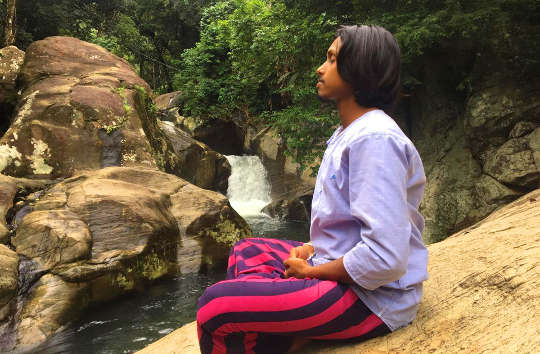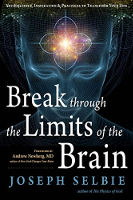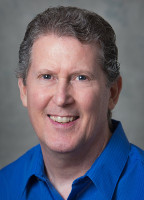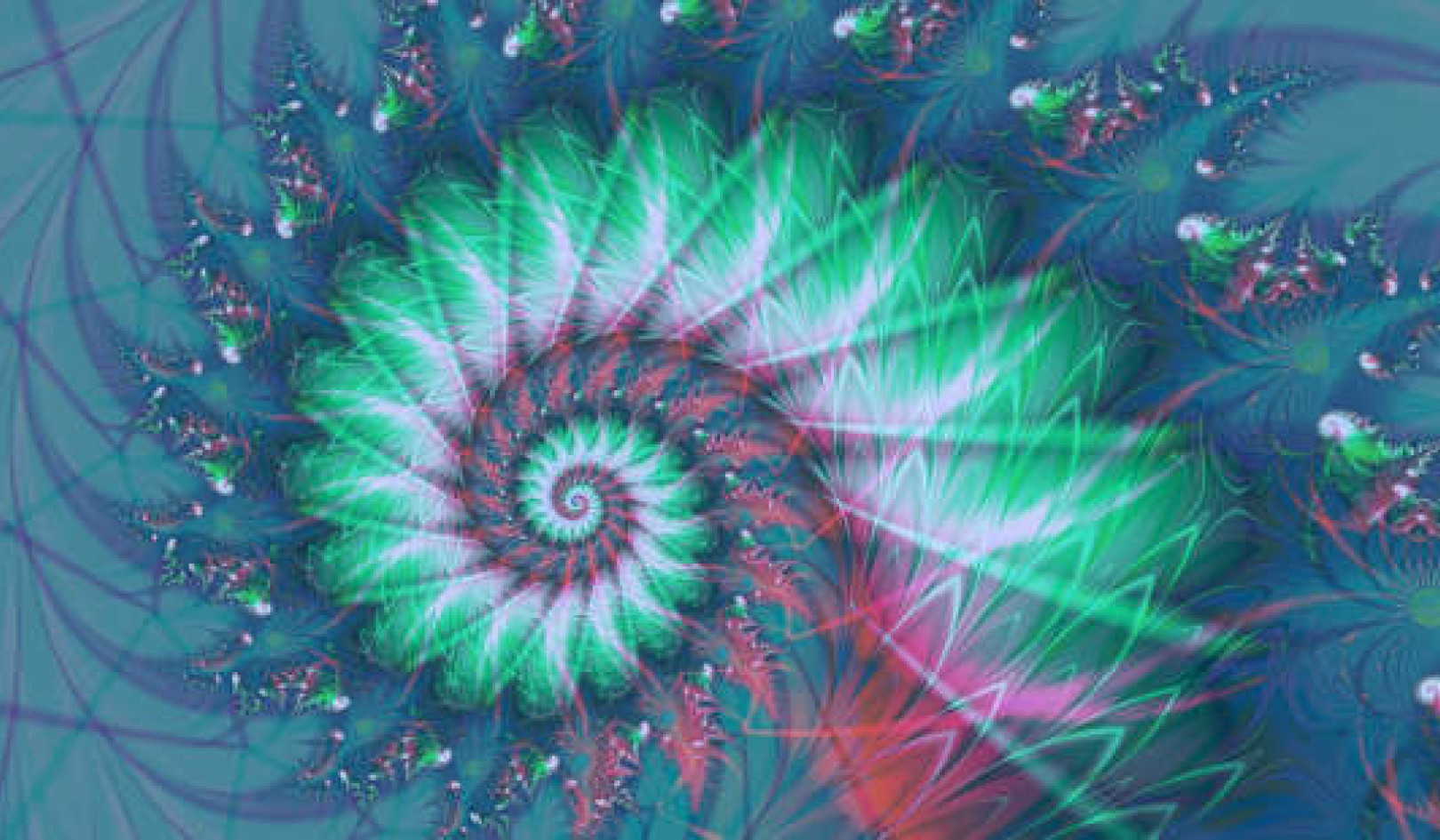
Image by sundarlanka
Meditation makes us more aware of our nonlocal energy body—our one foot in heaven—and this awareness makes us feel heavenly. Meditation gives us greater access to nonlocal realities: uplifting and harmonizing emotions, intuition and creativity, and an abundance of health-giving life force.
Meditation will make you feel better no matter why you are practicing it. A wise man once said, “If people only knew how good they would feel if they meditated, everyone would meditate.”
How to Meditate
I am going to teach you the Hong-Sau technique of meditation, which has been practiced in India for millennia. Why this particular technique rather than any other? My reason is simply that I have used this technique successfully for decades and I can therefore unhesitatingly recommend it.
If you already have another technique that you practice, or have an interest in practicing, by all means do so.
How to Sit for Best Results
Find a sitting position that allows you to sit as comfortably as you can with the spine erect and the body relaxed. You can sit in a chair, on a kneeling bench or kneeling pillow, or cross-legged with or without a pillow. All of these positions are equally effective. Deep meditators with many years of experience often use a chair for their meditations.
If you are sitting in a chair, sit with your feet flat on the floor and your thighs parallel to the floor. You can put a pillow under your feet if your legs are too short or a pillow on the seat of your chair if your legs are too long. Do not lean against the back of the chair. The idea is to sit with an upright, unsupported spine, with the body relaxed.
If you are not used to this position, or if the condition of your back makes it difficult, you can put a pillow between your back and the back of the chair. The feeling you want to have is that the pillow is supporting your upright position, not that you are leaning your weight against it. Adjust the pillow until you achieve this feeling.
Your choice of sitting position should allow you to relax the shoulders and keep the chin parallel to the floor with eyes facing directly forward. As an aid to keeping your spine erect rest your hands with the palms facing up at the juncture between thighs and torso.
If you prefer to sit on the floor, kneeling benches can help make your legs feel comfortable and help keep the spine straight. Those who are more comfortable sitting cross-legged on a pillow can try the crescent- shaped or round meditation pillows designed to help with this position, but any pillow you have that makes you comfortable will do just fine.
If you sit on the floor without a meditation pillow, make sure your spine is still straight, your shoulders relaxed, and your chin parallel to the floor with eyes facing directly forward. Your knees should remain close to the floor. If your knees do not remain close to the floor your spine will bend. Your position should allow you to place your hands comfortably, palms facing upward, at the juncture between thighs and torso.
Where to Meditate
If possible, set aside an area where you will not be disturbed and that you use exclusively for meditation. A small room, or a corner of your bedroom — even a closet can suffice, as long as it is well ventilated.
The place where you meditate should be a little on the cool side with a source of fresh air if possible, so that you are alert and awake.
Brief Preparation
Once you are sitting comfortably, I recommend doing two brief breathing exercises to relax and harmonize body and breath before you begin the Hong-Sau technique.
Tense and Relax
Inhale sharply through the nose, with one short and one long inhalation, while simultaneously tensing the whole body. Hold breath and tension for a few seconds, then exhale forcibly through the mouth, with one short and one long exhalation, simultaneously releasing the tension in your muscles. Repeat three to six times.
Balance Your Breathing
After you complete the tense- and- relax breathing exercise, inhale slowly, counting to eight, hold the breath for eight counts, then exhale slowly for eight counts. Without pausing, inhale again, hold, and exhale, once more to the count of eight. Repeat this exercise three to six times. You can vary the count according to your lung capacity, but always with inhalation, holding, and exhalation equal in length. Finish your practice by inhaling deeply, then exhaling completely.
Hong-Sau Technique of Concentration
You are now ready to begin the Hong-Sau technique. Close your eyes (if you haven't already). Wait for your next breath to come in of its own accord. When it does, mentally say hong (rhymes with song). Don't hold the breath. Exhale naturally. As you exhale, mentally say sau (rhymes with saw pr law). Hong sau is an ancient Sanskrit mantra. It means "I am He" or "I am Spirit."
Make no attempt to control the breath. Simply observe the breath as it flows naturally in and out. In the beginning you may be aware of your breath primarily in your chest and abdomen as your lungs expand and contract. As the breath grows calmer, focus your attention on the cool sensation in your nostrils when you inhale and the warm sensation in your nostrils when you exhale. Gradually become aware of the cool and warm sensations higher and higher in the nasal passages, until your awareness of the cool and warm sensations of the breath is focused at the point between the eyebrows.
Now also bring your closed eyes to a focus at the point between the eyebrows. Do not cross or strain your eyes. Your eyes should be relaxed, as if looking slightly up at some distant point. Without muscular tension, let your focus at the point between the eyebrows deepen, while continuing simply to observe the cool and warm sensations of the breath at the point between the eyebrows. If you find that your mind has wandered, gently bring it back to an awareness of the breath, to your mental repetition of hong and sau, and to your eyes' focus at the point between the eyebrows.
Once you reach the point where your awareness of the breath is centered at the point between the eyebrows try to become as focused at that point as you can without inadvertently tensing the facial muscles or holding the breath in or out. Try to feel as if your entire being is focused at this point. When you can do so, you will find a wonderful world opening to you. I will describe below some of the amazing things that can happen.
Sit in the Stillness
Finish your practice of Hong Sau by deeply inhaling and exhaling and then forget the breath. Concentrate deeply at the point between the eyebrows.
Keep your mind focused and your energy internalized. Absorb yourself in the peace generated by your practice. Continue for at least five minutes.
How Often and How Long to Practice
Try to practice Hong Sau at least once a day for fifteen minutes. As you come to enjoy it more, you can increase your time to thirty minutes, then to an hour or more— always leaving time at the end of your practice of Hong Sau to enjoy the peaceful and harmonious results. It is good to meditate twice a day, in the morning and at night. Find a schedule that works for you.
It is good to stretch your time meditating, but don’t strain. Doing a longer meditation once a week, about one and a half times to twice as long, will help you to increase the length and depth of your regular meditation.
What You Might Experience
Difficulty Staying Focused on the Breath
This is quite common. Don’t think yourself not capable or not “cut out” for meditation. It is a skill to learn just like any other. Be patient with yourself. Your concentration will improve.
Difficulty Not Controlling the Breath
This is also quite common. If this problem occurs every time you meditate, try doing more rounds of the preparatory breathing exercises before you begin your Hong Sau practice— tense and relax six or twelve times instead of three, do the balancing breath exercise six or twelve times as well.
Other solutions: try mentally dissociating yourself from the body by imagining that you are sitting slightly behind yourself and watching another body breathe. You can also consciously relax the area around the solar plexus: Trust that the body will breathe just as it should on its own.
Difficulty Sitting Still
Resist the impulse to make little adjustments to your position. If you successfully resist the impulse for even five minutes you will find that the body becomes more still. Also trust that sitting still will become more and more supported by rapidly forming neural meditation-habit circuits.
Your Breath May Become Deeper or More Shallow
You may find that your breath keeps the same rhythm but becomes more shallow. Or you may find that the rhythm of your breath slows and that both inhalation and exhalation become much deeper. Either is good.
Natural Pauses between Breaths Become Longer
This extended pause is normal and positive. Normal because in physical stillness your cells' lessened need to take in oxygen and expel carbon dioxide causes the breath to slow naturally. Positive because you will soon find these natural pauses between breaths to be calming, relaxing, and peaceful. Enjoy these moments particularly, but with no attempt to hold the breath. Forcibly holding the breath, in or out, will disrupt the calm, natural rhythm of your breathing.
Breath Rate Becomes Profoundly Slow
As you become more adept at Hong Sau you may find that you are breathing so shallowly or so slowly that it is difficult to be aware of the breath. This experience brings a wonderful feeling.
Heart Rate Becomes Profoundly Slow
Although your focus while practicing Hong Sau should not be on your heart rate, slowing of the breath rate will be accompanied by a corresponding slowing of the heart rate. Your heart will have slowed or stopped because your cells’ natural demand for oxygen is reduced or has stopped. As soon as you move or inhale, your cells will call for oxygen, and your heart rate will increase or resume just as naturally as it slowed or stopped.
Your Concentration Deepens
With practice you'll find that as the body becomes still, and the breath slows, the mind will slow as well. As the usual flow of thoughts slows, emotional tensions will be released, the body will fade from your awareness, and your concentration will become more and more one-pointed.
You Will Likely See Light
You may see various colors of light in the darkness behind your closed eyes. The light may be perceived at or around the point between the eyebrows. You may see white, blue or golden light, or a combination of all three. The light may form into a circle at the point between the eyebrows: a deep azure blue field surrounded by golden light, with a tiny white star in the center. This phenomenon, usually referred to as the spiritual eye, is mentioned in many experiential spiritual traditions, perhaps most familiarly to westerners in the New Testament: "if therefore thine eye be single, thy whole body shall be full of light." (Matthew 6:22)
You Will Likely Experience Emotional Release
Emotional relaxation is generally first experienced as a sense of peace and wellbeing. Deep emotional relaxation can feel as if a fist in your heart has relaxed or as if warmth is spreading outward from your heart.
You Will Likely Become Inwardly Absorbed in Superconscious Experience
There may be a sense of wellbeing wholly unrelated to anything happening in your life. There may be a thrill of energy rising in the center of your body that makes you feel energized, positive, and enthusiastic. There may be a feeling of sacred joy or of the "peace that passeth understanding."
Once experienced you'll know, as millions before you have come to know, that there is another world within you and that you are experiencing your superconscious Self in God.
Your Brain Will Rewire to Support Physical, Mental, and Emotional Health
Not only does meditation rewire the brain to support deeper meditation and superconscious awareness, over time the neural habit circuits that support meditation will expand and connect to other circuits in the brain and even alter the structure of brain regions.
Our neural meditation-habit circuit can fire to stimulate positive harmonizing emotions; by reducing stress it can activate healthy physiological processes such as detoxification, elimination, digestion, and healing, and can even activate genes that affect our physical, mental, and emotional health. Our neural meditation-habit circuit becomes, in time, the most significant positive influence on our health and wellbeing— it can even positively affect those around us.
In times of stress, or during emotional or mental challenges, our neural meditation-supporting, positive-emotion supporting, health-promoting circuits will also influence us to be less emotionally and negatively reactive. While the neural habit circuits that support negative emotions remain in the brain, our meditation-formed neural habit circuit will inhibit or dampen their firing.
Your Life Will Be Changed
The more we practice concentration in meditation the more concentrated we become in life. Concentration brings us intuitive insights we can use in all aspects of our lives. Problem- solving becomes easier and our solutions more creative. We become more focused and less easily distracted. Learning becomes accelerated. We become more efficient. Performance, in everything from sports to playing music, flows more naturally and with less tension. We become more present in the moment.
The more we practice meditation the more our life improves. Minor health issues may fade away. We may find ourselves more open, considerate, lovingly compassionate, and more spontaneously helpful toward others. We may find ourselves more centered and less reactive in our emotions. We may find that we flow through our day with less resistance. We simply become happier.
Meditate. Meditate regularly. Meditate as deeply and for as long as you can. Meditate. It will change your life.
Copyright 2022. All Rights Reserved.
Book by this Author:
BOOK: Break Through the Limits of the Brain
Break Through the Limits of the Brain: Neuroscience, Inspiration, and Practices to Transform Your Life
by Joseph Selbie
 Break Through the Limits of the Brain connects the dots between the discoveries of neuroscience and the meditation-born spiritual experience. It debunks scientific materialism’s brain-based explanation for consciousness and intelligence—including the brain-as-supercomputer and artificial intelligence models—and explains the view of many prominent and open-minded scientists that an all-pervading intelligent consciousness is the foundation of reality—an age-old belief shared by saints, sages, mystics, and those who’ve had near-death experiences.
Break Through the Limits of the Brain connects the dots between the discoveries of neuroscience and the meditation-born spiritual experience. It debunks scientific materialism’s brain-based explanation for consciousness and intelligence—including the brain-as-supercomputer and artificial intelligence models—and explains the view of many prominent and open-minded scientists that an all-pervading intelligent consciousness is the foundation of reality—an age-old belief shared by saints, sages, mystics, and those who’ve had near-death experiences.
Meditation is a central theme of the book—what it is; how to do it; why it works; its physical, mental, and emotional benefits as measured by neuroscientists; and how it rewires the brain for superconscious awareness so you can achieve whatever you put your mind to. The book offers proven practices for bringing superconscious awareness into your life for success, energy, health, peace of mind, and lasting happiness.
For more info and/or to order this book, click here. Also available as an Audiobook and as a Kindle edition.
About the Author
 Joseph Selbie makes the complex and obscure simple and clear. A founding member of the meditation-based community Ananda and a dedicated meditator for over forty years, he has taught yoga and meditation throughout the United States and Europe. He is the author of the popular The Physics of God and The Yugas. He lives with his wife at Ananda Village near Nevada City, California.
Joseph Selbie makes the complex and obscure simple and clear. A founding member of the meditation-based community Ananda and a dedicated meditator for over forty years, he has taught yoga and meditation throughout the United States and Europe. He is the author of the popular The Physics of God and The Yugas. He lives with his wife at Ananda Village near Nevada City, California.
Visit the author's website at JosephSelbie.com





























